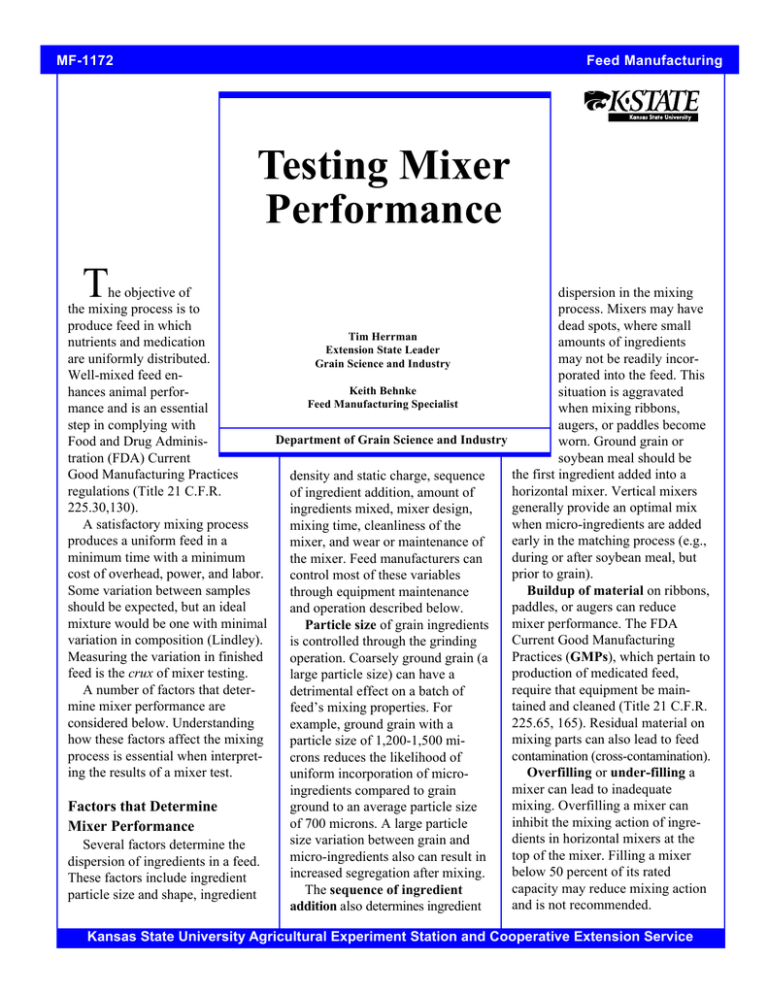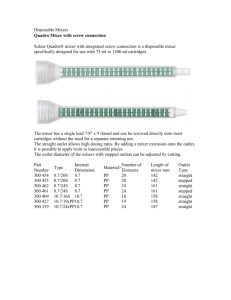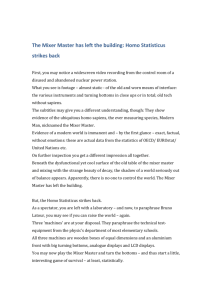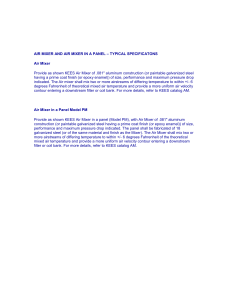
1
MF-1172
Feed Manufacturing
Testing Mixer
Performance
T
he objective of
the mixing process is to
produce feed in which
Tim Herrman
nutrients and medication
Extension State Leader
are uniformly distributed.
Grain Science and Industry
Well-mixed feed enKeith Behnke
hances animal perforFeed
Manufacturing
Specialist
mance and is an essential
step in complying with
Department of Grain Science and Industry
Food and Drug Administration (FDA) Current
Good Manufacturing Practices
density and static charge, sequence
regulations (Title 21 C.F.R.
of ingredient addition, amount of
225.30,130).
ingredients mixed, mixer design,
A satisfactory mixing process
mixing time, cleanliness of the
produces a uniform feed in a
mixer, and wear or maintenance of
minimum time with a minimum
the mixer. Feed manufacturers can
cost of overhead, power, and labor.
control most of these variables
Some variation between samples
through equipment maintenance
should be expected, but an ideal
and operation described below.
mixture would be one with minimal
Particle size of grain ingredients
variation in composition (Lindley).
is controlled through the grinding
Measuring the variation in finished
operation. Coarsely ground grain (a
feed is the crux of mixer testing.
large particle size) can have a
A number of factors that deterdetrimental effect on a batch of
mine mixer performance are
feed’s mixing properties. For
considered below. Understanding
example, ground grain with a
how these factors affect the mixing
particle size of 1,200-1,500 miprocess is essential when interpretcrons reduces the likelihood of
ing the results of a mixer test.
uniform incorporation of microingredients compared to grain
Factors that Determine
ground to an average particle size
of 700 microns. A large particle
Mixer Performance
size variation between grain and
Several factors determine the
micro-ingredients also can result in
dispersion of ingredients in a feed.
increased segregation after mixing.
These factors include ingredient
The sequence of ingredient
particle size and shape, ingredient
addition also determines ingredient
dispersion in the mixing
process. Mixers may have
dead spots, where small
amounts of ingredients
may not be readily incorporated into the feed. This
situation is aggravated
when mixing ribbons,
augers, or paddles become
worn. Ground grain or
soybean meal should be
the first ingredient added into a
horizontal mixer. Vertical mixers
generally provide an optimal mix
when micro-ingredients are added
early in the matching process (e.g.,
during or after soybean meal, but
prior to grain).
Buildup of material on ribbons,
paddles, or augers can reduce
mixer performance. The FDA
Current Good Manufacturing
Practices (GMPs), which pertain to
production of medicated feed,
require that equipment be maintained and cleaned (Title 21 C.F.R.
225.65, 165). Residual material on
mixing parts can also lead to feed
contamination (cross-contamination).
Overfilling or under-filling a
mixer can lead to inadequate
mixing. Overfilling a mixer can
inhibit the mixing action of ingredients in horizontal mixers at the
top of the mixer. Filling a mixer
below 50 percent of its rated
capacity may reduce mixing action
and is not recommended.
Kansas State University Agricultural Experiment Station and Cooperative Extension Service
2
The mixing time necessary to
produce a homogenous distribution
of feed ingredients should be
measured for each mixer. Mixing
time is a function of mixer design
and the rotational speed of the
ribbon, paddle, or auger. The best
way to establish the appropriate
mix time is to conduct a mixer
performance test.
Mixer Performance Testing
Mixer performance testing
consists of two parts: sampling and
sample analysis. Procedures for
sampling mixers, analyzing
samples, and interpreting results
are described below.
Sample Collection
The first step in mixer testing
involves collecting representative
feed samples. This process depends
on the type (horizontal versus
vertical) and design of the mixer.
For example, it is difficult to
collect a representative sample
directly from a vertical mixer using
a grain probe, hence, collecting
samples at evenly spaced intervals
during mixer discharge is recommended.
Samples can be taken from the
spout end of portable grinders/
mixers or near the discharge point
for a stationary vertical mixer.
Horizontal mixers are usually
accessible from the top which
permits sample collection directly
from the mixer using a grain probe.
Samples should be drawn from
10 predesignated locations or at
even intervals during mixer discharge. Identify the location, or
time sequence, by numbering the
sampling bags; this step will help
one interpret the data (see Figure 1).
Ten samples are advised; this
recommendation is based on the
statistical analysis procedures
described in step 3 of Sample
Evaluation. Mixer test results are
less accurate when fewer samples
(data points) are used.
If you are evaluating mixer
performance using a micro-ingredient that requires an expensive
laboratory assay, (e.g. drug), it may
become necessary to make a trade
off between the cost and accuracy
of the test.
To select the optimum mixing
time, feed samples must be collected at intervals over an extended
period. For example, a horizontal
mixer can be evaluated for optimal
mixing time as follows: run the
mixer for two minutes, stop the
mixer and collect 10 representative
samples from predetermined
locations, run the mixer two more
minutes, stop the mixer and collect
ten samples from the same locations as the previous sampling.
Repeat this process for ten minutes
(five sampling times).
As mentioned above, it is
difficult to collect samples directly
from vertical mixers. In this
instance, a sampling scheme will
involve separate batches of feed
that have different mixing times. It
is important to perform this test
using the same feed ration and
same sequence of ingredient
addition to the mixer.
Safety precautions must be
followed when sampling a mixer.
In every instance, use proper
lockout, tag-out procedures (disengage power) before reaching into a
mixer to collect a sample. Do not
place your hands near moving
augers when collecting samples
during mixer discharge.
Sample Evaluation
Sample evaluation involves 1)
selecting the micro-ingredient or
tracer to test for feed uniformity; 2)
assaying the samples for the
specified ingredient level; 3)
analyzing the data collected during
samples analysis; and 4) interpreting the data.
Step 1: Selecting
a Micro-ingredient
A micro-ingredient is defined as
an ingredient that comprises 0.5
percent or less of the final feed.
Testing mixer performance using a
micro-ingredient will provide a
better indication of feed uniformity, since micro-ingredients are
typically more difficult to incorporate into a large batch of feed.
Salt is a commonly recommended micro-ingredient to test
mixer performance. Salt is common
in most feeds, it comes from only
one source, and it is both inexpensive and easy to perform a salt
assay. Physical characteristics that
make salt an attractive ingredient
for testing include the following: it
is more dense than most feed
ingredients, its shape is generally
cubic rather than spherical, and it is
smaller than most other particles. If
the mixer will uniformly incorporate salt, those ingredients with
more typical physical properties
(shape and density) should pose no
problem during mixing.
Step 2: Assaying Procedures
Assaying samples for salt
content may be performed using
several techniques. The sodium
(Na+) or chloride (Cl-) ions from
salt (NaCl) may be analyzed after
mixing the feed sample in a water
solution. “Quantab” (Environmental Test Systems, Elkart, Indiana)
3
Interpretation of Mixer Tests
Percent Coefficient of Variation
<10%
Rating
Excellent
Corrective Action
None
10-15%
Good
Increase mixing time by 25–30%
15-20%
Fair
Increase mixing time 50%, look for worn
equipment, overfilling, or sequence of
ingredient addition
>20%
Poor
Possible combination of all the above.
Consult extension personal or feed equipment
manufacturer.
Step 3: Data Analysis
The average salt concentration
(mean) and variation between
samples (standard deviation) are
calculated to arrive at a single
value described as the coefficient
of variation (CV). A desirable CV
for a well mixed feed, using the salt
assay method, should be at or
below 10 percent. Calculating the
coefficient is performed using the
following equation:
%CV = yS x 100
y=
∑ yi
n
s2=∑(yn-1)-ny
2
6
5
4
3
1
2
Figure 1. Sampling scheme used to evaluate mixing performance in a horizontal
paddle mixer.
∑
yi
= sum
= individual sample
analysis results
= total number of
samples
2
i
where:
%CV = percent coefficient of variation
s
= standard
deviation
2
s
= variance
y
= mean
8
7
n
2
s=s
10
9
chloride titrators measure the
dissolved Cl-, while the Omnion
Sodium Analysis involves a meter
with a specific sodium electrode
that measures the Na+ (Omnion,
Inc., Rockland, Massachusetts).
Inexpensive calculators are
available that are programmed with
a statistical function that automatically calculates the coefficient of
variation or the standard deviation
and mean.
Step 4: Interpreting the Results
A CV below 10 percent is
considered a good mix. Variation
in the assay procedure may be as
high as 5 to 6 percent, indicating
that the actual variation due to
mixing is about 5 percent. If the
CV is over 10 percent, increase the
mix time and/or inspect the system
for factors that caused the poor
ingredient distribution (e.g.,
sequence of ingredient addition or
particle size).
4
Example 1.
To illustrate the variation in salt
concentration for a feed sample,
consider the following example.
Samples were taken from a horizontal paddle mixer with a 2-ton
capacity using a 4-foot grain probe.
Quantab titrators were used to
measure the salt ion content with
the following results:
Location
1
2
3
4
5
6
7
8
9
10
Mean
Standard Deviation
Coefficient of Variation
Salt (%)
0.24
0.51
0.55
0.42
0.59
0.55
0.59
0.59
0.64
0.55
0.523
0.1156
22.10%
The sampling scheme that was
followed is illustrated in Figure 1.
The lowest salt concentration was
at location 1 (53 percent less than
the mean concentration) and the
highest salt concentration was at
location 9 (23 percent greater than
the mean concentration). Salt was
added to the mixer as a premix
after ground grain and soybean
meal. The auger used to convey the
premix discharged near the center
of the mixer. Complete feed was
discharged from the mixer end
where samples 9 and 10 were
drawn.
Results suggest that insufficient
mixing action (or time) resulted in
a low micro-ingredient distribution
at one end of the mixer. Possible
corrective action could include
positioning the premix auger closer
to sampling locations 1 and 2 (end
opposite to the mixer discharge
port) or increasing mixing time
from 3 to 5 minutes.
A particle size evaluation
revealed that ground milo was
1,150 microns. Adjusting the roller
mill to reduce particle size below
800 microns should improve mixer
performance and feed efficiency in
this example.
Literature Cited
Lindley, J. A. 1991. Mixing
processes for agricultural and food
materials: 1. fundamental of
mixing. Agric. Engng Res.
48.153-170
Title 21, Code of Federal
Regulations, Part 225.30 and 130.
Equipment. 1993 ed.
Title 21, Code of Federal
Regulations, Part 225.65, 165.
Equipment Cleanout Procedures.
1993 ed.
Brand names appearing in this publication are for product identification purposes only. No endorsement is intended,
nor is criticism implied of similar products not mentioned.
Publications from Kansas State University are available on the World Wide Web at: http://www.oznet.ksu.edu
Contents of this publication may be freely reproduced for educational purposes. All other rights reserved. In each case, credit Tim Herrman
and Keith Behnke, Testing Mixer Performance, Kansas State University, October 1994.
Kansas State University Agricultural Experiment Station and Cooperative Extension Service
MF-1172
October 1994
It is the policy of Kansas State University Agricultural Experiment Station and Cooperative Extension Service that all persons shall have equal opportunity and
access to its educational programs, services, activities, and materials without regard to race, color, religion, national origin, sex, age or disability. Kansas State
University is an equal opportunity organization. Issued in furtherance of Cooperative Extension Work, Acts of May 8 and June 30, 1914, as amended. Kansas
State University, County Extension Councils, Extension Districts, and United States Department of Agriculture Cooperating, Marc A. Johnson, Director.





